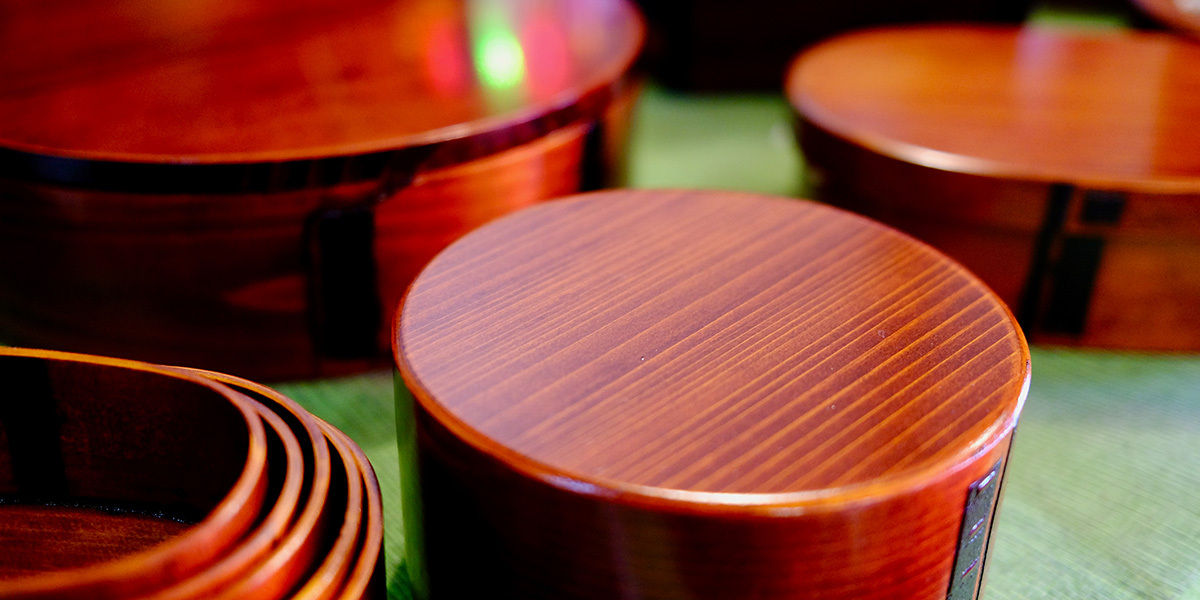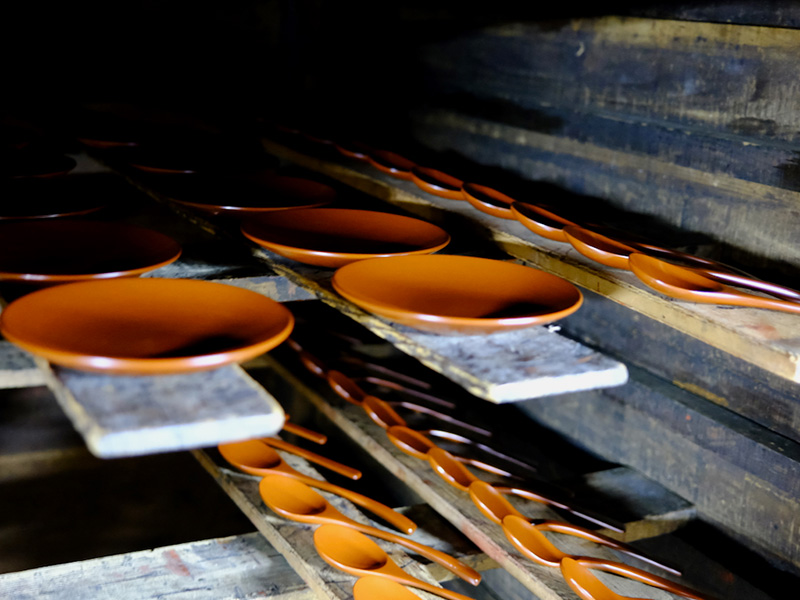The Lacquerware of Kiso Hirasawa
Encounter traditional Japanese townscapes and traditional crafts
Update:2022/02/01

After passing through the beautiful streets of Narai-juku and walking along the old Nakasendo highway for about two kilometers, you will eventually see a stone marker for the Lacquerware Town of Kiso Hirasawa.
Unlike other towns along the Nakasendo, it wasn’t a place for travelers to stay, rather a place for artisans to live and produce lacquerware products. Even today, it retains the atmosphere of an old lacquerware craftsman's town, with a historical townscape and many active lacquerware producers. It is a must-visit town on the Nakasendo, especially if you are interested in traditional Japanese townscapes and traditional crafts.


Kiso Lumber and Nakasendo Lacquer
Lumber was one of the Kiso Valley’s greatest natural resources, and many kinds of wood were grown and harvested here. In particular, the Kisogoboku, five varieties of cypress and conifer tree, were prized for their high quality.
The Owari Domain, which ruled over Kiso from distant Nagoya Castle, strictly regulated the lumber industry. The prohibitions on logging were referred to by an expression that translates as, “One Tree, One Head.” In short, anyone that cut a tree down without permission would be put to the sword. In addition, a barrier, known as Shiraki Aratame Bansho, was constructed in Kiso to control the flow of lumber.

Since local villagers lived under the patronage of the Owari domain, the residents of the area were allowed to use a certain amount of wood to make a living. This resulted in the development of several woodworking industries in Kiso, and the birth of a variety of white-wood crafts, ranging from daily necessities to ornaments. Kiso's location on the Nakasendo highway made it a key point for east-to-west transportation and trade, eventually leading to the introduction of lacquer and the development of Kiso lacquerware.
What is Lacquerware?
Lacquer comes from the sap of the Chinese lacquer tree that grows only in Asia. This substance has been heavily used in Japan over the centuries as a coating to increase the strength and durability of wood products.


The beautiful luster of lacquerware was well-suited to luxury goods, so most lacquerware items were produced for the upper class. Such pieces often featured brilliant maki-e designs, like Wajima-nuri from Ishikawa. On the other hand, Kiso lacquerware spread among the local people out of practical necessity. The result was a less glamorous but more durable and easier-to-use product, which was highly prized by common folk in the Edo period. Originally, they were sold as souvenirs in the nearby towns like Narai-juku, but over time their reputation spread across the nation, and this lacquerware from Kiso made its way to major cities such as Edo and Osaka via the Nakasendo.
Strolling the Streets of Kiso Hirasawa
Unlike many other towns along the Nakasendo, Kiso Hirasawa, located about 2.3km from Narai-juku, was not a post town. In other words, it wasn’t built to host travelers. Instead, workers and tradesmen who supported the nearby post towns lived here. Even now the history of the town can be seen in the many lacquerware shops that line the streets.


The main street of Kiso Hirasawa along the old Nakasendo is filled with impressive buildings. Each building consists of a main house, a back house, a courtyard, and a storehouse used in the production of lacquerware. The street-facing main house acts as a lacquerware store, while the back and courtyard are a private living space. At the end of the courtyard is a two-story storehouse. Dozens of houses built like this line the street, forming the townscape.



A good example of this style of house is Itoh Kanji Shoten. Beautiful Kiso lacquerware lines the storefront, drawing in customers. The back of the store opens to a large courtyard and beyond it is a warehouse that is over 100 years old. These storehouses are known as Nurigura, and several craftsmen work applying layer after layer of lacquer to tea bowls. Not all of the storehouses are open to tourists, but you can find QR codes with a link to watch videos of the lacquerware being made.
Kiso Lacquerware: Artisans and Production
Only the very best Japanese craftsmen are certified as traditional craftsmen. Mr. Masatake Miyahara is the head of the organization of traditional craftsmen of Kiso lacquerware.

The Miyahara family’s history dates back to the Edo period when they worked as officials at the guardhouse that controlled the export of lumber in Kiso. The family still has an old document regarding the allotment of Japanese cypress, as proof of their family's long history in the area. Mr. Miyahara has worked in lacquerware making for as long as he can remember, and his children are also Kiso lacquerware craftsmen. He was kind enough to demonstrate his process of making lacquerware.


Making lacquerware is difficult and requires a great deal of skill and experience. The lacquer itself must be mixed differently depending on the item’s shape and use, and furthermore, the craftsman must take into account changes in humidity and other environmental factors when applying it. It takes at least 30 days to complete one piece by going through the process of applying the lacquer to the wood, drying it, and then applying it again.
Kiso lacquerware, handcrafted by skilled artisans, is simple but elegant. The more you use it, the more the luster of the lacquer grows, and as it grows in age so does your attachment to it. Longtime users continue to use their older lacquerware by keeping it in good repair.
Just like the travelers who traversed the Nakasendo in the Edo period, travelers today can choose a lacquerware souvenir while enjoying the view of the Kiso mountains. Bento lunch boxes, known as menpa, are a very popular item among tourists. A variety of Kiso lacquerware goods are available at each of the lacquerware stores lining the street, as well as the Kiso Lacquerware Museum.


Kiso Lacquerware Museum
If you want to learn more about Kiso lacquerware, you should visit the Kiso Lacquerware Museum located between Hirasawa and Narai-juku. The museum shows the tools used in the production of lacquerware and the production process and has interesting items such as an Olympic medal made of lacquerware used in the 1998 Nagano Winter Olympics.
Lacquerware found a foothold in the Kiso region thanks to the quality lumber and freedom given to the local residents to use lumber to make a living. The lacquerware here is part of a long tradition that has been passed down by masters like Mr. Miyahara today. The many storefronts that make up the historical townscape offer a variety of goods that make for practical souvenirs and give visitors a chance to support the local industries and take in the history of the area.




